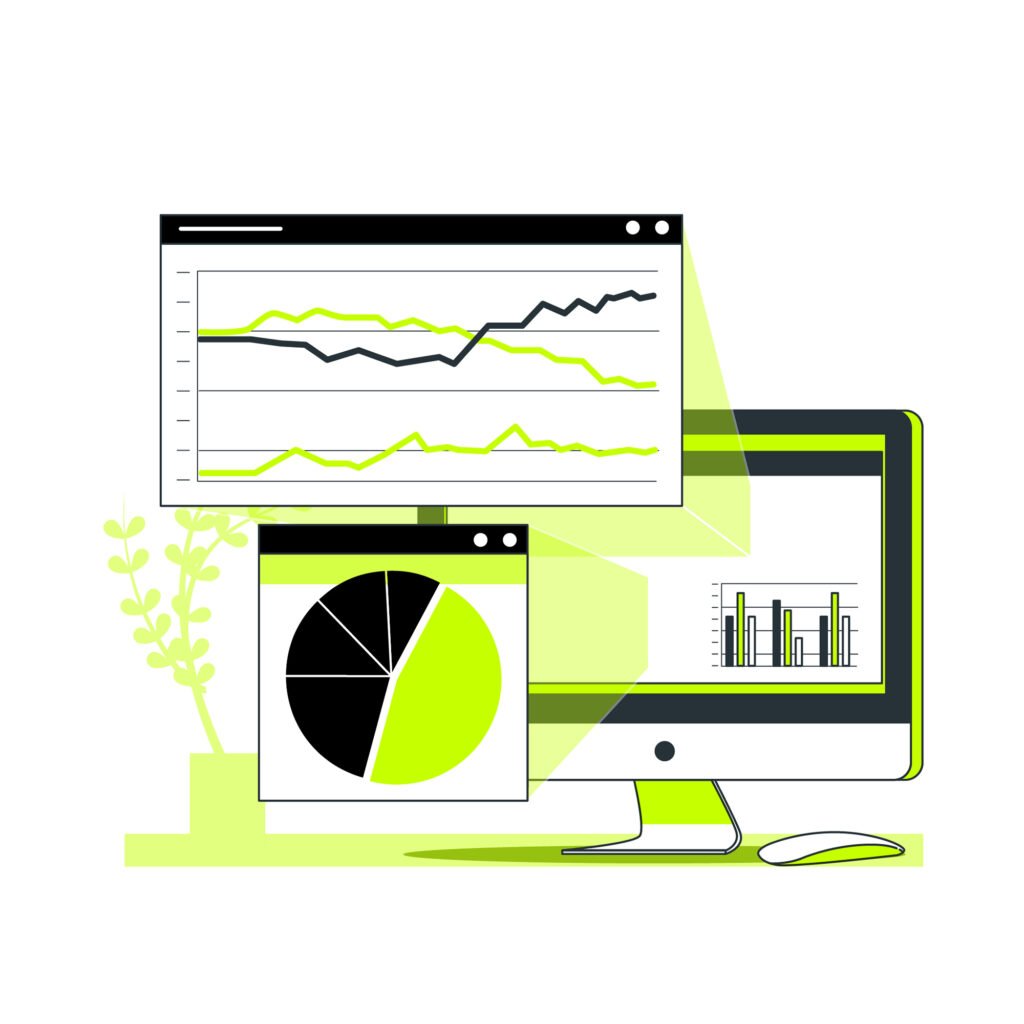- The Capabilities and Potential Benefits of Using Business Intelligence
- Advanced Data Analytics Techniques for Business Intelligence
- Data Visualization for Business Intelligence
- Leveraging Business Intelligence for Personalized Customer Experiences
- Overcoming Challenges in Implementing Business Intelligence
- Conclusion
Unleashing the Potential of Data: Leveraging Business Intelligence for Competitive Advantage
30 Aug 2023
Igor Kelly

Most companies collect daily business data from enterprise resource planning (ERP) software, e-commerce platforms, and other internal and external sources. To benefit from this data and make data-driven decisions, they need a modern business intelligence (BI) system that presents data in visualized ways (various charts, maps, graphs, interactive dashboards and more), making it easy for human perception and analysis.
Business intelligence is paramount in today’s competitive landscape as it empowers organizations to make data-driven decisions, gain valuable insights for long-term planning, and stay ahead of the competition. , BI tools and analytics enable businesses to benefit from vast amounts of data, to identifying market trends and opportunities, understanding customer behavior more comprehensively, and more.
In this article, we will delve into the concept of business intelligence, its capabilities and potential benefits, and how you can add value to your customer data.
The Capabilities and Potential Benefits of Using Business Intelligence
Imagine you are a captain on the high seas without a compass and chart. Without these tools you are not able to steer in the right direction and avoid escaping from upcoming storms. Similarly, in today’s digital era, businesses can quickly go off course without the help of BI.
Business intelligence encompasses various techniques and software solutions to meticulously scrutinize organizational data. It transforms it into valuable insights that empower every company member to make well-informed and strategic choices. A BI system, also known as a decision support system, analyzes current and historical data and presents the results in easy-to-understand reports, dashboards, graphs, charts, and maps that can be used across the organization.
How widespread is BI infrastructure? According to the latest research conducted by Fortune Business Insights, the global business intelligence market demonstrated substantial growth, reaching a value of $27.11 billion in 2022. Projections indicate further expansion, with the market expected to reach an impressive &54.27 billion by 2030, reflecting a robust CAGR of 9.1% during the forecast period.
Overall, the role of business intelligence is to improve all parts of an organization by facilitating access to the organization’s data and then using that data to increase profitability. By integrating BI practices with machine learning algorithms, companies can unlock actionable insights into their business processes, fueling strategic decisions that boost productivity and propel accelerated expansion.
The potential benefits of business intelligence tools include:
- Enhanced decision-making;
- Optimization of internal business processes;
- Increased operational efficiency;
- Increase in revenue;
- Competitive advantages over peers in the market;
- Early market trends identification
- Fostering data-driven culture
Moreover, BI data can include historical information stored in a data warehouse and new data generated from the source systems, allowing BI tools to support strategic and tactical decision-making processes.
Leveraging business intelligence helps businesses to overcome a lack of data integration or poor data organization with capabilities we highlight below.
Advanced Data Analytics Techniques for Business Intelligence
Advanced data analytics involves the use of sophisticated techniques to analyze large and complex datasets, extracting valuable insights and patterns that might not be apparent through traditional analysis.
Data analytics techniques are crucial for Business Intelligence (BI) as they enable organizations to transform raw data into actionable insights, facilitating informed decision-making. These techniques provide a deeper understanding of business operations, customer behaviors, and market trends, enhancing the effectiveness of BI tools in delivering strategic advantages and driving organizational success.
A common distinction is that BI focuses on the past and the present (descriptive analysis). Let’s look at the broader scope of BI capabilities.
Descriptive analytics — what was before?
IT experts compare current and historical data from different sources to describe the status quo and identify trends and patterns in the data. For example, they can analyze past and present sales data to identify trends and patterns, helping a retail company understand which products have been consistently popular over the last year.
Diagnostic analytics — why is this happening?
IT experts use the results of descriptive analytics to identify factors or reasons for specific historical performance values. For example, they might uncover that a sudden drop in website traffic was due to a recent server outage during a peak usage period, leading to a better understanding of the performance issue.
Predictive analytics — what happens next?
IT experts use predictive modeling, deep learning, and machine learning to exploit the results of descriptive and diagnostic analytics. Based on this, they can foresee future events such as customer purchase behavior and market trends for a e-commerce platform to adjust inventory levels and optimize supply chain management in advance.
Prescriptive analytics — how do I achieve my goal?
Both predictive analytics and prescriptive analytics are subcategories of advanced analytics. Prescriptive analytics uses algorithms, application testing, and machine learning, among other things, to find solutions for defined results. For example, a transportation company can employ optimization algorithms to determine the most efficient routes and schedules for their delivery trucks, minimizing fuel costs and ensuring timely deliveries.
The final functional component of the BI architecture deals with reacting to the received business insights. The company can adjust its marketing strategy based on consumer preferences and market trends to better target the audience and increase sales.
After the information is distributed in a visualized form, it forms the basis for the well-founded, data-driven decisions of managers, CEOs, department heads, and other decision-makers — and for competitive intelligence to gain a comprehensive understanding of their market and audience, and develop more accurate strategies.
Manual collecting and analyzing data on customer feedback can be extremely time-consuming and inaccurate due to subjectivity. Text analytics in BI solutions helps eliminate these issues by streamlining this process through data collection and analysis automation. You can obtain this data in seconds, gaining real-time insights into your customer satisfaction.
A sentiment score evaluates each review based on the specific language used, which allows you to analyze and interpret large amounts of text. There are two main types of this methodology.

Emotion-based sentiment analysis
Emotion-based sentiment analysis assesses responses with a range of emotions, including joy, disgust, fear, anger, trust, sadness, anticipation, and surprise. The result can be beneficial not only for understanding how your customers feel but also for seeing if certain products or advertisements invoke a specific emotional response. With it, you can segment customer base more precisely, thus improving your targeting strategy.
Aspect-based sentiment analysis
Aspect-based sentiment analysis provides enhanced insight into customer responses by extracting frequently used words, enabling a deeper comprehension of the primary topics discussed in reviews. This is particularly useful in today’s customer-centric world because it will enable you, as a business, to read between the lines of customer reviews and gain a better understanding.
By harnessing the power of BI, organizations gain valuable insights from data and analytics solutions, enabling them to respond to market changes. Real-time analytics contributes to ROI optimization and gaining a competitive edge.
Data Visualization for Business Intelligence
We live in a data-driven world, as translating complex data into shareable formats and easy-to-understand reports is a major task nowadays. Сomprehensive infographics and interactive reports help to present large amounts of data understandably.
How do BI visualization capabilities make data more human-understandable? Basically, raw data speaks a very precise language that few specialists can understand. Well-designed infographics and data storytelling take this flat, numerical information and create a contextual narrative that people of any profession and technical competence can grasp and relate to.
The human brain prefers stories to pure data. You’ve probably seen examples of data storytelling without realizing it. That’s part of its beauty: because it’s visually appealing, it doesn’t feel like you’re slogging through data. For example, the World Health Organization tracks COVID-19 worldwide in an interactive dashboard. Readers can view the number of COVID cases, deaths, or vaccinations, the measures taken by each country, and dozens of easy-to-understand visualizations.
This is a perfect case of how modern data visualization for business intelligence offers numerous advantages over spreadsheets, data whiteboards, and digital dashboards. Data-backed stories are compelling because they:
- Simplify the overwhelming amount of data, thus preventing potentially ineffective decisions. According to Gartner, AI workloads are expected to drive infrastructure decisions significantly by 2023, with computational resources utilized in AI increasing by five times compared to 2018.
- Engage more brain parts than pure data, increasing understanding and personal involvement.
- Can illustrate why something is happening.
- Are backed up by visible evidence.
- Use data to uncover new patterns among the existing ones.
- Able to utilize both readers’ emotions and intellect.
Below, you will find the most widely used data visualization platforms within business intelligence infrastructure.
Tableau
Tableau is among the most popular data visualization tools handling networking, data analysis, and evaluation. It seamlessly integrates diverse data sources like Excel, spreadsheets, BigQuery, SQL Server, Amazon Redshift, and more.
Power BI
Microsoft Power BI, a user-friendly business analytics solution, compiles data from various sources to create Power BI reports, providing independence from data sources and delivering clear results. With products like Power BI Desktop, Mobile, and Pro, it effortlessly merges with other Microsoft tools for enhanced capabilities.
Data Wrapper
Datawrapper Core by Datawrapper GmbH is a visualization tool that prominent organizations like The New York Times, Thomson Reuters, WEF, and Axios use. It empowers users to create charts, data tables, and reports without coding or design expertise. The platform seamlessly integrates with Slack and Microsoft Teams, providing live updates for visualizations connected to dynamic datasets.
Domo
Domo’s business cloud offers comprehensive application software for data extraction, storage, modeling, analysis, and visualization, including 150 charts and over 7,000 maps for developers’ customization. Domo excels in real-time data change alerts, centralized data governance, cloud flexibility, and an all-in-one platform with app-building capabilities, catering to clients like eBay, Cisco, NBA, Unilever, and ESPN.
Qlik
Qlik Sense, an intelligent data analysis platform, enables easy data integration, visualization, and evaluation for every employee within the company. Utilizing AI for predictive analysis, Qlik aids in planning reports and data charts. The platform is accessible from any device, including iOS and Android, and is preferred by companies like Volvo, Lenovo, DocuSign, HSBC, and Samsung.
Google Looker
Looker, a part of Google Cloud, offers a highly customizable and easily implemented tool compatible with various custom codes and supports 50+ SQLs. It facilitates joining multiple datasets with BigQuery, Snowflake, and Redshift. Additionally, IT experts can export data and create visualizations in PDFs, Excel spreadsheets, or image files.
Flourish
Flourish enables scalable and interactive content management by organizations like BBC, Accenture, UNDP, and the Rockefeller Foundation. As part of the Canva family, Flourish allows chart and map creation, supports unlimited free public views, and enables data upload directly from Excel, along with mobile support and simple website embedding.
Lightpoint provides business intelligence as a service, and if you are interested in maximizing profitability from your data, schedule a consultation with our BI expert.

Leveraging Business Intelligence for Personalized Customer Experiences
You may have noticed that marketing has become more and more personalized in recent years. Customers receive ads from targeted marketing campaigns and got used to experiences that are tailored to them. According to Salesforce, 52% of customers expect offers to always be personalized.
Data-driven marketing is emerging as a powerful force in the business world, and to stay competitive, your business must resort to personalization. Real-time analytics gives you a more detailed view of your customers’ behavior. How does it help you better understand their wants and needs?
Strategic intelligence compiles data from diverse touchpoints along the customer journey, including but not limited to the data sources listed below.
- Demographic insights. Unveil crucial information about the age, gender, location, and other demographic factors that shape your target audience and refine customer segmentation.
- Pain point analysis. Delve into customer pain points and challenges, providing valuable insights into areas where improvements and innovations are needed.
- Purchasing behavior tracking. Analyze customer purchasing habits and patterns, offering valuable clues to optimize product offerings and marketing strategies.
- Preferred channels and habits. Gain insights into customer content consumption preferences, enabling the customization of marketing campaigns to align with individual interests.
How to maximize the effectiveness of BI used for personalization? Consider the following recommendations:
- Design for the target audience. Tailor the dashboard to ensure that the specific target audience receives only pertinent and essential information.
- Provide context. Ensure that data — like sales or profit — includes essential milestone dates or year-over-year comparisons so stakeholders can understand trends.
- Drive actionable insights. Optimize the visualization to present information that is relevant for stakeholders when decision making.
- Avoid clutter. Less is more! Avoid overwhelming the dashboard with an excessive number of visual elements.
Overcoming Challenges in Implementing Business Intelligence
In a digitally supported work concept, companies can flexibly base the selection of BI tools on their specific requirements. Still, despite the BI’s adaptiveness, many struggle with adopting BI practices for a few reasons.
- Excessive database complexity. When it comes to user experience (UX), finding the information experts need is often difficult because of the complexity of the reports. There’s a considerable risk of blurring the focus because only part of the possible range of BI tools’ functions is used, while the rest runs along as unnecessary ballast. In this case, it is worth identifying excess features and content to exclude or eliminate them.
- Expensive maintenance of the existing systems. Many companies are interested in profitable investments in operational software. But the support for the operating or database systems has long since expired, and hardly anyonecan service, maintain and operate them. Therefore, it can be much more expensive than investing in a more robust system. However, new systems are often much cheaper to maintain and offer much more regarding reliability, availability, and scalability. System administrators should consider replacing old items with new ones.
- Long response times to data analysis. Real-time processing can cost the company dearly. The goal should be that the ETL (Extract, Load, Transform) system can process data much faster.
Lightpoint tackles these major challenges by analyzing four vital pillars of B2B customers: the company itself, employees, processes, and technologies used. Collaborating with customers, we develop tailored analytics strategies to address specific subject areas.
Conclusion
BI provides companies access to numerous data analysis techniques that help them avert business challenges and grow the business. Therefore, data-driven decision-making provides an irreplaceable competitive edge over others.
By adopting the advanced data analytics techniques we discussed above, you can bridge gaps between the past, present, and future. BI reporting and data visualization tools not only lay out business processes for individuals and teams but also clearly show what needs to be done in a particular case.
Overall, BI is worth investing in as it provides all users with diverse data analysis from a single source of truth using attractive interactive dashboards, paginated reports, and embedded analytics. It’s important to mention that it takes time and resources to sort through data to provide valuable insights, so if you need a cost-effective BI solution followed by expert guidance, feel free to contact a Lightpoint expert for a profound consultation.


